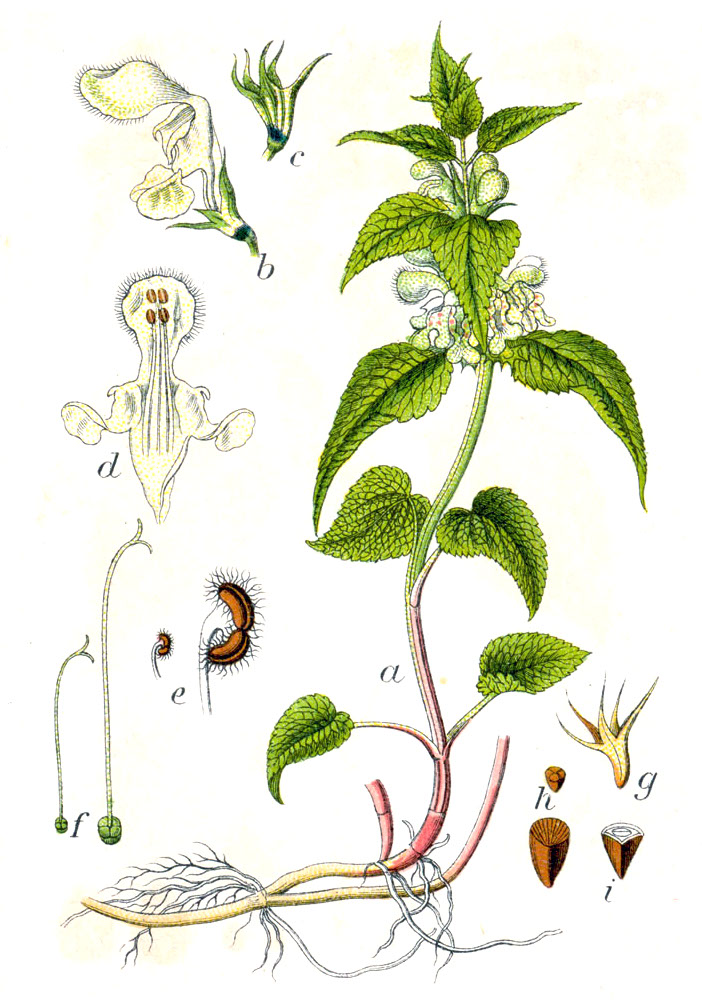Lamium album L.- Lamiaceae - white dead nettle, Weiße Taubnessel
Perennial herb, 20-50cm high, native to Eurasia, naturalized in eastern North America; leaves opposite, triangular-ovate, toothed, minutely hispid; flowers white or yellowish-white.
The dried flowers (Lamii albi flos, Flores Lamii albi) are traditionally used as expectorant.
[Medicinal Plants of the World. Ben-Erik Van Wyk and Michael Wink, Pretoria 2004, 187]
Alboside A and B are secoiridoids from Lumium album L. where they co-occur with lamalbid. They are derived from 8-epi-deoxyloganic acid. Caryoptoside is an intermediate in the biosynthesis of lamalbid and alboside B.
[Biosynthesis of iridoid glucosides in Lamium album., Damtoft, S., Jensen, S. R., Nielsen, B. J., Phytochemistry, Vol.31(1), 1992, 135-137]
„Two phenylpropanoid glycosides, a new one, lamalboside (2R-galactosylacteoside) and the known acteoside, the flavonol p-coumaroylglucoside, tiliroside, 5-caffeoylquinic acid (chlorogenic acid), along with rutoside and quercetin and kaempferol 3-O-glucosides were isolated from the flowers of Lamium album. Esters of glycosides were obtained as mixtures of trans/cis isomers. The presence of flavonoid p-coumaroylglucosides links Lamium to other members of the subfamily Lamioideae.“
[Phenylpropanoid esters from Lamium album flowers. Budzianowski, J., Skrzypczak, L., Phytochemistry, Vol.38(4), 1995, 997-1001]
„Phytochemical study of the aqueous extract of the flowering tops of Lamium album led to identification of the antiviral iridoid isomers lamiridosins A and B (1, 2). These compounds were found to significantly inhibit hepatitis C virus entry (IC50 2.31 μM) in vitro.
According to an open label clinical observation study conducted in the Dominican Republic, a product prepared from the extract of a mixture of herbs was reported to be effective in the treatment of HCV infections. In that study, the levels of the hepatic enzymes ALT and AST were normalized after 45 days of oral treatment, and viral loads were decreased significantly in patients who did not respond to standard interferon treatment. The formulation used in that study contained aqueous extracts from three herbs including that of the flowering tops of Lamium album L. (Lamiaceae). In our laboratories, evaluation of a commercially prepared aqueous extract of this plant material showed that it was active against HCV in an HCVpp (HCV pseudoparticles) entry assay. Subsequent bioactivity-guided phytochemical studies of a methanol extract prepared from the dried flowering tops of L. album resulted in the isolation of an iridoid glucoside, lamalbid (lamiridoside).
Although this iridoid glucoside was inactive against HCVpp, the corresponding aglycone (nonsugar portion) and its inseparable epimer, which we named lamiridosins A/B, were found to be significantly active against HCVpp. Further study of analogues showed that these compounds represent a group of specific anti-HCVpp agents that target viral entry into host cells.“
[Lamiridosins, hepatitis C virus entry inhibitors from Lamium album., Zhang, H., Rothwangl, K., Mesecar, A. D., Sabahi, A., Rong, L., Fong, H. H., Journal of natural products, Vol.72(12), 2009, 2158-2162] http://www.lamiridosin.eu/descargas/HCV_Inhibitors.pdf

